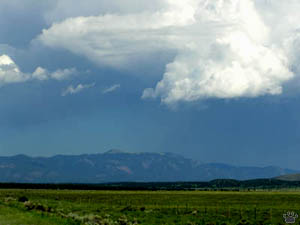
Storm over Magdalena Mountains, New Mexico.
Part 3. Death with No Name
| In 2004, I briefly worked for another rodent trapping
project, this time at the University of New Mexico. It was an expensive, long-term
research effort with no clear scientific objective. Originally it was supposed
to show the connection between high precipitation, rodent numbers and outbreaks
of a disease caused by rodent-born hantavirus. This connection has been known
to Navajo healers for centuries. |
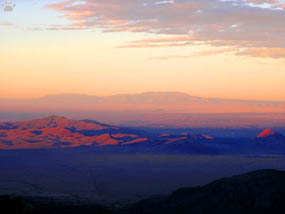 |
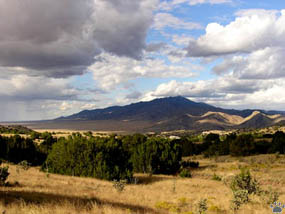 |
| Sevilleta National Wildlife Refuge,
New Mexico. |
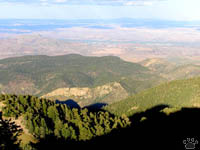
View from Magdalena Mts, New Mexico. |
Unlike Colorado project described
in previous pages, this study was marked by sloppy science
and poor management. I was happy to leave as soon as the field
season was over. |
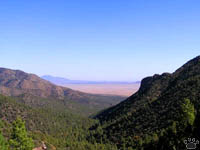
View from Magdalena Mts, New Mexico. |
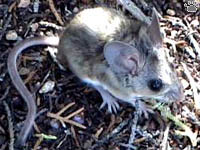
Brush mouse (Peromyscus boylii), Placitas,
New Mexico. |
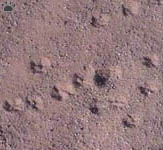
Tracks of deer mouse (P. maniculatus),
Hogback Ridge, New Mexico. |

Baby brush mouse, Zuni Reservation,
New Mexico. |
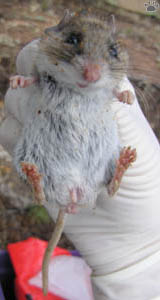
Brush mouse, Placitas. |
The so-called Sin Nombre ("nameless")
Virus, a.k.a. SNV, was discovered during the infamous 1992
outbreak on Navajo Reservation. It rarely infects humans,
but can cause high mortality rates. Deer mouse (see previous
page) is the main carrier, but other Peromyscus
species also get it sometimes.
Due to poor selection of study sites, we didn't catch that
many deer mice, but instead enjoyed working with a wide variety
of rodents. Up to five species of Peromyscus occured
in some locations. Sometimes they were a bit difficult to
tell apart. I strongly suspect that we've captured one or
two hybrid animals, too. |
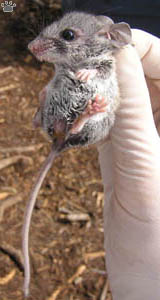
Baby brush mouse, Zuni Reservation. |
 |
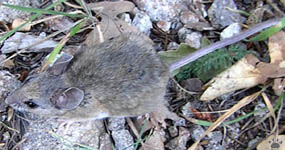 |
| Cactus mouse (P. eremicus),
Sevilleta NWR, New Mexico. |

White-footed mouse (P. leucopus),
Amarillo, Texas. |
Although each of these species has
slightly different ecological preferences, there is a lot of overlap. My personal
favorite, and the commonest one in most locations, was the pinyon mouse (P.
truei). |

Canyon mouse (P. crinitus),
Navajo Reservation, New Mexico. |
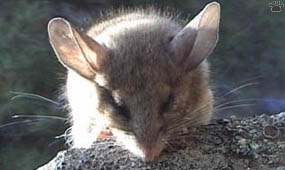 |
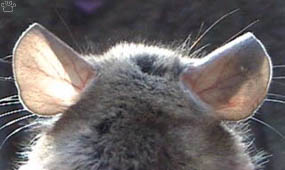 |
| Pinyon mice,
Hogback Ridge. |
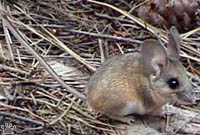
Pinyon mouse, Sevilleta NWR, New Mexico. |
Pinyon mouse favors pinyon-juniper woodlands,
but can also be found in pine forests, oak groves, bushes and rocky canyons. It
has the largest ears (proportionally) of all North American rodents. |
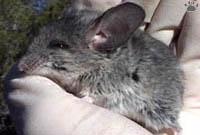
Baby pinyon mouse, Gallup, New Mexico. |
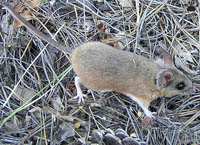
Pinyon mouse, Sevilleta NWR, New Mexico. |
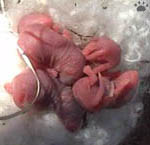
Newborn pinyon mice, Placitas. |
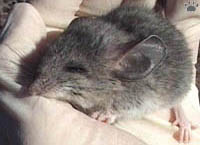
Baby pinyon mouse, Gallup. |
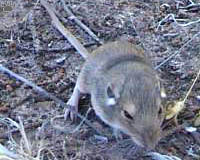
Plains pocket mouse (P. flavescens), Zuni. |
Technically, only the eastern
1/3 of New Mexico is part of the Great Plains. But other areas
also have a lot of Plains species, often occuring high up
the dry mountain slopes, such as two local species of Perognathus
pocket mice. |

Plains pocket mouse, Zuni. |

Silky pocket mouse (P. flavus),
Zuni. |
Pocket mice are the smallest rodents in New Mexico.
They are easy to find by spotlighting, but are often too light to set off traps.
Apparently, they never carry hantavirus of any kind. |
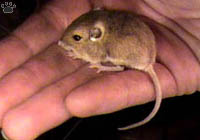
Silky pocket mouse,
Placitas. |
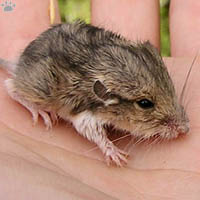 |
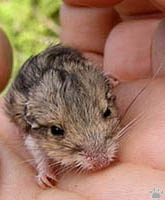 |
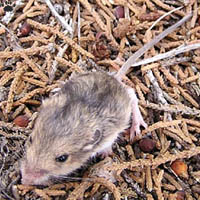 |
| Baby silky
pocket mice, Placitas. |
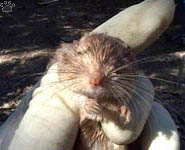
Rock pocket mouse, Sevilleta NWR. |
The diversity of habitats in New Mexico is much
higher than on the Plains. Some Peromyscus and rock
pocket mouse (Chaetodipus intermedius) have adapted
to rocky environments, such as steep slopes and canyon walls. |

Rock pocket mouse, Sevilleta NWR. |
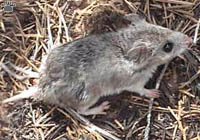
Northern grasshopper mouse (Onychomys
leucogaster), Zuni Reservation. |
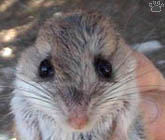
Southern grasshopper mouse (O.
torridus), VLA, New Mexico. |

Mearns' grasshopper mouse (O. arenicola),
Sevilleta NWR. |

Baby Northern grasshopper mouse, Zuni. |
Three species of grasshopper mice can be found
in New Mexico. Descendants of Peromyscus, they have evolved into ferocious
predators who hunt large insects and mice. Some of them like to have their belly
scratched. |
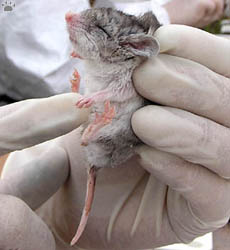
Baby Northern grasshopper mouse, Zuni. |

White-throated woodrat (Neotoma albigula),
Mangas Mountains, New Mexico. |

Stephens' woodrat (N. stephensi),
Chaco Canyon NHP, New Mexico. |

Southern Plains woodrat (N. micropus),
Mangas Mts, New Mexico. |
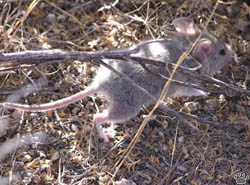
Baby white-throated woodrat, Gallo Mts, New Mexico. |
Woodrats are very common in New Mexico. They are
cute and smart, but often difficult to handle. |
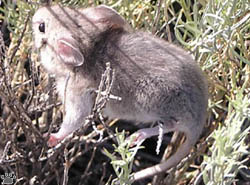
Baby Southern Plains woodrat, Sevilleta NWR. |
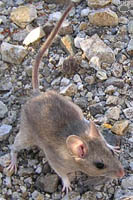
Mexican woodrat (N. mexicana),
Magdalena Mts. |
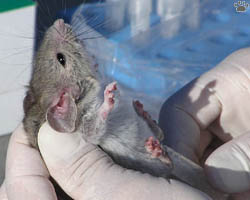
White-throated woodrat, Valles Caldera Natural Preserve,
New Mexico. |
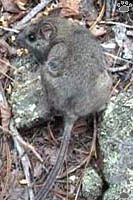
White-throated woodrat,
Magdalena Mts. |
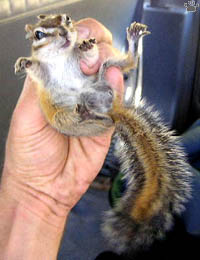
Cliff chipmunk (Tamias dorsalis), Navajo Res. |
We also trapped a lot of other rodents: chipmunks,
voles, squirrels, kangaroo rats. Just like pocket mice, they
had nothing to do with hantavirus. Still, we had to follow
the protocol and spend countless hours measuring them, taking
blood and tissue samples, then carrying back to trapping sites
to release. It was a huge waste of time, but useful practice
for me. |
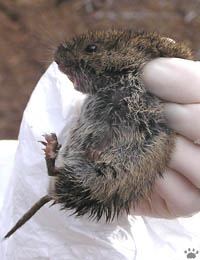
Montane vole (Microtus montanus), Mangas Mts. |
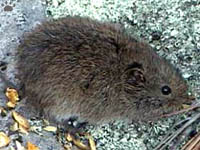
Mogollon vole (M. mogollonensis), Mangas Mts. |
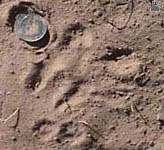
Kangaroo rat tracks, Zuni. |

Ord's kangaroo rat (Dipodomys ordii), Zuni. |

Seeds of oneseed juniper (Juniperus
monosperma), Hogback Ridge. |
Deer mice and many other rodents were most common
near seeding juniper trees. I suspect that juniper mast, not grass growth, is
the real trigger of SNV outbreaks. |

Hispid cotton rat (Sigmodon hispidus),
Lordsburg Playas, New Mexico. |
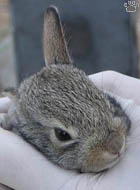 |
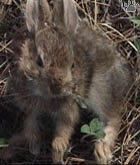 |
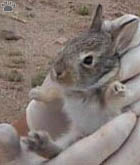 |
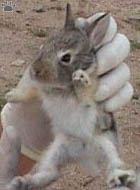 |
Baby desert cottontails (Silvilagus
audubonae),
Placitas, New Mexico. |
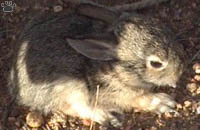
Baby desert cottontail, Placitas. |
Occasionally, we would get other animals into
our traps: from beetles and crickets to baby rabbits and snakes. It was always
fun to release them, even the less-friendly ones. |
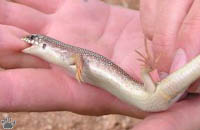
Great Plains skink (Eumeces obsoletus), Placitas. |
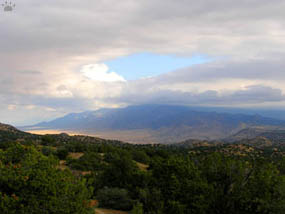 |
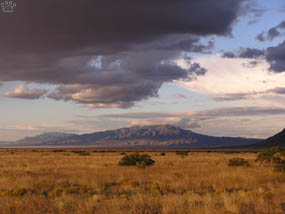 |
| Sevilleta National Wildlife Refuge,
New Mexico. |

Southern part of Sevilleta is more remote: some
people working
there for years have never seen it. |
But the best part of the job was getting to work
in great places throughout the state, especially in Sevilleta NWR and Valles
Caldera. Within view of Albuquerque, they are mostly off-limits for general
public; some parts are almost never visited by people. |
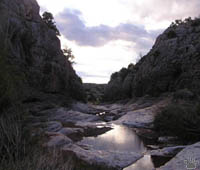
This remote box canyon in Sevilleta is used by
mountain lions and other wildlife. |
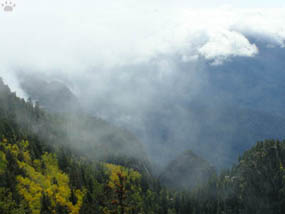 |
 |
| October in Sandia Mountains, New
Mexico. |
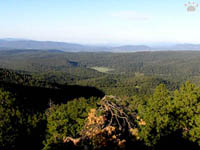
View from the summit of Mangas Mountains. |
I also met some nice people while working in New
Mexico, and traveled around a lot: even wrote a few research papers on my spare
time. So, that field season of rodent trapping was not a total loss, after all. |
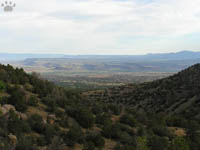
View from the Sandia Mountains. |
Home
|